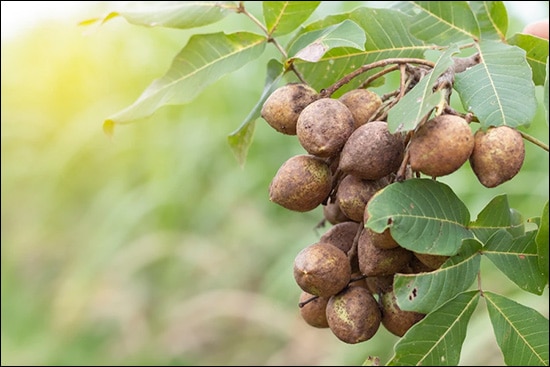Koshamra / Ceylon Oak (Schleichera Oleosa)- Ayurvedic Properties, Effects On Doshas & Dosage
Description
Ayurveda is a traditional, holistic approach originating from India, herbal medicines offer strong protection from diseases. Ayurveda practices always hold a torchlight in our hard times to help in cleansing the body, it includes dietary changes, has various means to show its effectiveness through panchakarma therapy, following Dincharya, proper Ahar-vihar, and yogasanas. There are many herbs that are highly prestigious for their medicinal properties. Schleichera oleosa is commonly known as ‘Koshamra’ in Ayurveda. This tropical tree is readily found in Asia and is a large deciduous tree. It is widely used in various skin ailments, its bark is rich in antioxidant properties, and works against rheumatoid arthritis, pain in joints, and headache. Oil prepared by this herb is good for ulcers, and parasitic infections. Schleichera oleosa is composed of Triterpenoids, taraxerone, and tricadenic acid A.

Special Note About This Plant
- Ceylon tress, Lac tree, Gum lac tree, is the English name of Koshamra herb, this herb belongs to the family Sapindaceae.
- This herb is used for the management of skin ailments and is highly used for blood purification.
- This species is globally distributed in Indo-Malesia. It is distributed almost throughout India.
- A medium-sized tree grows 10-15 m in height in forests
- Ruchikarak – Appetiser, Deepana- pachana – good in digestion, grahi – absorbent.
Systemic Classification
- Botanical Name – Schleichera oleosa
- Family – Sapindaceae
- Genus – Schleicher
- Species – S. oleosa
Synonyms
- Koshaamra, Kshudraamra – Fruit resembles mango
- Lakshaa vrksha – Laksha formed on trees
- Ghanaskandha – Dense trees
Other Vernacular Names
- In Hindi – Kusum
- In English – Lac tree, Macassar Oil tree, Honey tree, Ceylon Oak
- In Kannada – Sagade, kendala, jendalacekota
- In Tamil – Puvathipuvam, Pulaachi, pumarata
- In Malayalam – Puvam
- In Telugu – Posuku, busi, kodalipulusu, botanga, madakapulusu, sagadipusuku
Habitat
- A medium-sized tree grows 10-15 m in height in forests
- Leaves are paripinnate, alternate, simple, spinosely serrate, sessile, and leaflets are elliptic and large.
- Fruit berries in shape.
- Flowers are yellow in colour, small and racemose.
- This herb is widely distributed in dense forest areas all over India.
Classical Categorization
- Acharya Sushrut added this herb in Nyagrodhadi ganna and Amladi Varga.
- Acharya Charak has mentioned this herb in Amla Skanda.
- Acharya Vagbhat has also described this herb in Nyagrodhadi gana.
- Dhanwantri Nighantu categorised this wonderful herb as Amradi Varga and its oil is kept under the Amradi phalavarga.
- Kaiyadev Nighantu mentioned this herb in Oshadhadi Varga.
Ancient Verse
Shloka – 1
कोशाम्रः कुष्ठशोथास्रपित्ताव्रणकफापह:।
तत्फलं ग्राही वातघ्नमम्लोष्णं गुरु पित्तलम।
पक्वनतु दीपनंरुच्यम लघुष्णं कफवातनुत्।।
Reference – BhavPrakash Nighantu/ Amradiphala Varga
Interpretation of Shloka – Koshamra herb is good for skin diseases, edematous swellings, blood disorders, epistaxis, ulcers, hyper nephrosis, herniations, abscess formation, deafness, vaginal diseases, and ear diseases.
Shloka – 2
कोशाम्रोऽम्ल: कटु: पाके वीर्योष्णोऽथानीलापह:।
कफपित्तकारो रूच्या: कुष्ठघ्नो रक्तशोधन:।।
Reference – Dhanvantari Nighantu/ Amradi Varga
Interpretation of Shloka – This herb is sour, pungent in post-digestive effect, hot in potency, pacifies Vata, aggravates the Pitta dosha and Kapha dosha and is a great appetiser, cures leprosy, and acts as an alternative.
Ayurvedic Properties
- Rasa (Taste) – Amla (Sour)
- Guna (Quality) – Guru (Heavy)
- Veerya (Potency) – Ushna (Hot)
- Vipaka (Post digestive effect) – Katu (Pungent)
- Karma (Action) – Balances the Vata and Kapha dosha
- Projyang (Part used) – Stem bark and seed oil are used
Effects On Doshas
This herb balances the Vata and Kapha dosha and may aggravate the Pitta dosha.
Practical Uses
- This herb is widely used to manage Vata Kapha diseases. Its unripened fruit is good for the pacification of vata dosha and aggravates the Kapha pitta dosha.
- Its ripened fruit is good for Kapha-vata dosha.
- Its local application may reduce pain, itching, and skin diseases, and is good for hair/
- Its ripened fruit is a great absorbent, and is a great appetiser, enhancing the digestive fire.
- This is also good for the purification of blood and is good for skin diseases.
- The bark is used to diminish the fever and is even useful in Vaginal diseases.
- In lower back pain, the paste of the powdered Koshamra is very effective.
- Its local application is also beneficial for wounds in animals.
- Its decoction is also used for feverish feelings.
- This is also good for Hair fall.
- It is also used in Vata vriddhi diseases and in many other cleansed intestines.
Dosage
- The juice of the leaves can be taken up to 10-15 ml
- Powder can be taken up to 2-4 gram
- The decoction can be taken up to 50-100ml
Ayurvedic Products
-
Koshamra oil



